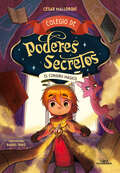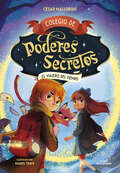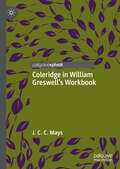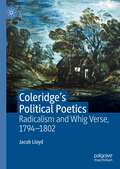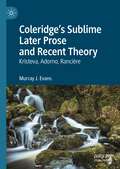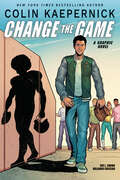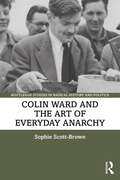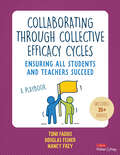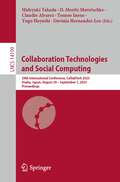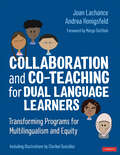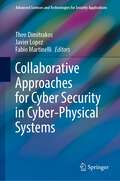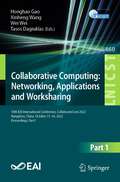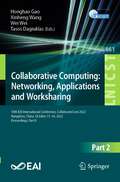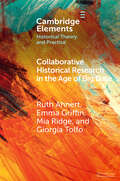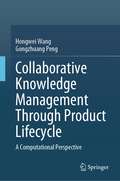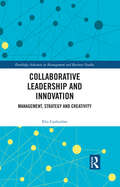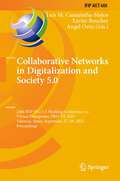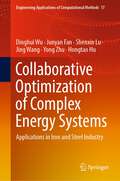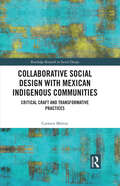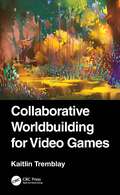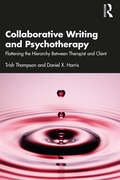- Table View
- List View
Colegio de poderes secretos 2 - El conjuro mágico (Colegio de poderes secretos #Volumen 2)
by César MallorquíEl colegio en el que querrías estudiar. Misterios, poderes secretos y aventuras inimaginables... ¡Bienvenido, ya eres un nuevo alumno! Axel tiene un don. Y también tiene a Trece, un gato gruñón que habla. Dos razones importantes para poder estudiar en el Colegio de Poderes Secretos, donde tiene amigos increíbles como Lola, una niña muy especial capaz hacer crecer las plantas. Aunque pronto descubrirán que el colegio está en peligro.¿Podrán Axel, Lola y sus mascotas salvar a sus compañeros?
Colegio de poderes secretos 3 - El viajero del tiempo (Colegio de poderes secretos #Volumen 3)
by César MallorquíEl colegio en el que querrías estudiar. Misterios, poderes secretos y aventuras inimaginables... ¡Bienvenido, ya eres un nuevo alumno! Axel tiene un don. Y también tiene a Trece, un gato gruñón que habla. Dos razones importantes para poder estudiar en el Colegio de Poderes Secretos, donde tiene amigos increíbles, como Lola y su ratón, que se llama Goliat.Cuando un bebé con poderes extraordinarios aparece en el colegio, Axel y sus amigos descubrirán un nuevo misterio a través del espacio y del tiempo. ¡Aquí cada día es una aventura! Mascotas parlantes y mucha magia en una colección para lectores aprendices: -Texto sencillo y fácil de entender para lectores a partir de 7 años. ¡Quedarán hechizados por el poder de la lectura! -Ideal para lectores amantes de la fantasía y las aventuras más emocionantes. -Un libro que es pura magia con ilustraciones a todo color en cada página.-Una trama deslumbrantemente encantadora y divertida. ¡No podrás resistir su poderosa llamada! -Un mundo mágico creado por el autor bestseller César Mallorquí, que ha cautivado a más de 200.000 lectores.
Coleridge in William Greswell’s Workbook
by J. C. MaysThis book provides a critical and biographical account of the fascinating hand-made book of rector William Greswell (1848-1923), in which he assembled British and American reviews and accounts of the Romantic poet, critic, philosopher, and religious thinker Samuel Taylor Coleridge (1772-1834). J.C.C. Mays re-evaluates Coleridge’s nineteenth-century reputation through the lens provided by Greswell’s workbook. Mays demonstrates how Coleridge is one of the most complicated and influential religious thinkers of the nineteenth century, whose “religious musings” (most prominently as published in Aids to Reflection and On the Constitution of the Church and State, but also in posthumous collections such as Confessions of an Inquiring Spirit) cast a long shadow over religious thinking in nineteenth-century England and America. Although Greswell was but one of Coleridge’s many readers in the nineteenth century, his engagement with Coleridge’s writings was noteworthy for the sheer mass of the materials he assembled, and the breadth of the Coleridge he depicts. Greswell’s Coleridge is a Coleridge in whom all Coleridgeans will be interested.
Coleridge's Political Poetics: Radicalism and Whig Verse 1794 - 1802
by Jacob LloydThis book considers Samuel Taylor Coleridge’s engagement with ‘Whig poetry’: a tradition of verse from the eighteenth century which celebrated the political and constitutional arrangements of Britain as guaranteeing liberty. It argues that, during the 1790s, Coleridge was able to articulate radical ideas under the cover of widely accepted principles through his references to this poetry. He positioned his poetry within a mainstream discourse, even as he favoured radical social change. Jacob Lloyd argues that the poets Mark Akenside, William Lisle Bowles, and William Cowper each provided Coleridge with a kind of Whig poetics to which he responded. When these references are understood, much of Coleridge’s work which seems purely personal or imaginative gains a political dimension. In addition, Lloyd reassess Coleridge’s relationship with Thomas Percy’s Reliques of Ancient English Poetry, to provide an original, political reading of ‘The Rime of the Ancyent Marinere’. This book revises our understanding of the political and poetic development of a major poet and, in doing so, provides a new model for the origins of British Romanticism more broadly
Coleridge’s Sublime Later Prose and Recent Theory: Kristeva, Adorno, Rancière
by Murray J. EvansThis book explores the sublime in Samuel Taylor Coleridge’s later major prose in relation to more recent theories of the sublime. Building on the author’s previous monograph Sublime Coleridge: The Opus Maximum, this study focuses on sublime theory and discourse in Coleridge’s other major prose texts of the 1820s: Confessions of an Inquiring Spirit (wr. 1824), Aids to Reflection (1825), and On the Constitution of the Church and State (1829). This book thus ponders the constellations of aesthetics, literature, religion, and politics in the sublime theory and practice of this central Romantic author and three of his important successors: Julia Kristeva, Theodor Adorno, and Jacques Rancière.
Colin Kaepernick: Change the Game (Graphic Novel Memoir)
by Eve L. Ewing Colin KaepernickColin Kaepernick: Change the Game is an inspiring high school graphic novel memoir for readers 12 and up from celebrated athlete and activist Colin Kaepernick.A high school senior at a crossroads in life and heavily scouted by colleges and Major League Baseball (MLB), Colin has a bright future ahead of him as a highly touted prospect. Everyone, from his parents to his teachers and coaches, is in agreement on his future. Everyone but him.Colin isn’t excited about baseball. In the words of five-time all-star MLB player Adam Jones, “Baseball is a white man’s sport.” He looks up to athletes like Allen Iverson: talented, hyper-competitive, unapologetically Black, and dominating their sports while staying true to themselves. College football looks a lot more fun than sleeping on hotel room floors in the minor leagues of baseball. But Colin doesn't have a single offer to play football. Yet. This touching YA graphic novel memoir explores the story of how a young change-maker learned to find himself, make his own way, and never compromise.
Colin Ward and the Art of Everyday Anarchy (Routledge Studies in Radical History and Politics)
by Sophie Scott-BrownColin Ward and the Art of Everyday Anarchy is the first full account of Ward’s life and work. Drawing on unseen archival sources, as well as oral interviews, it excavates the worlds and words of his anarchist thought, illuminating his methods and charting the legacies of his enduring influence.Colin Ward (1924–2010) was the most prominent British writer on anarchism in the 20th century. As a radical journalist, later author, he applied his distinctive anarchist principles to all aspects of community life including the built environment, education, and public policy. His thought was subtle, universal in aspiration, international in implication, but, at the same time, deeply rooted in the local and the everyday. Underlying the breadth of his interests was one simple principle: freedom was always a social activity.This book will be of interest to students, scholars, and general readers with an interest in anarchism, social movements, and the history of radical ideas in contemporary Britain.
Collaborating Through Collective Efficacy Cycles: A Playbook for Ensuring All Students and Teachers Succeed
by Douglas Fisher Nancy Frey Toni Osborn FaddisDevelop and sustain collective efficacy in your school to energize teachers and students alike. In today’s schools, working together and learning together go hand in hand. Collective efficacy is educators’ beliefs, fueled by evidence, that by working together—as a collective, rather than as individuals—they will positively impact student and teacher learning. So how can teachers put collective efficacy into action? Collaborating Through Collective Efficacy Cycles: A Playbook for Ensuring all Students and Teachers Succeed demystifies the concept of collective efficacy and empowers teacher teams with the necessary tools to ignite collaborative processes, pool energy and resources, determine their impact, and foster mutual accountability at a schoolwide level. Step by step, the authors guide readers through six modules, leading them through a full cycle and helping set a foundation to systematically cultivate collective efficacy. The playbook offers background information, evidence-based research, and practical strategies and tools to help educators: Establish detailed conditions for creating collective teacher efficacy, using data to identify student learning needs and determine a common challenge Plan collectively, implement strategy, and observe colleagues in deliberate classroom practices that deepen expertise and facilitate increased student and teacher learning Select learning opportunities to bolster knowledge and enhance professional skills surrounding evidence-based practices that address needs and accelerate learning Define how teacher teams can cultivate and increase motivation and energy as individuals and, equally importantly, with one other. While content changes, this established process can be used repeatedly, offering teacher teams a clear and defined pathway towards personal and professional fulfillment while simultaneously elevating student motivation, well-being, and academic success.
Collaborating Through Collective Efficacy Cycles: A Playbook for Ensuring All Students and Teachers Succeed
by Douglas Fisher Nancy Frey Toni Osborn FaddisDevelop and sustain collective efficacy in your school to energize teachers and students alike. In today’s schools, working together and learning together go hand in hand. Collective efficacy is educators’ beliefs, fueled by evidence, that by working together—as a collective, rather than as individuals—they will positively impact student and teacher learning. So how can teachers put collective efficacy into action? Collaborating Through Collective Efficacy Cycles: A Playbook for Ensuring all Students and Teachers Succeed demystifies the concept of collective efficacy and empowers teacher teams with the necessary tools to ignite collaborative processes, pool energy and resources, determine their impact, and foster mutual accountability at a schoolwide level. Step by step, the authors guide readers through six modules, leading them through a full cycle and helping set a foundation to systematically cultivate collective efficacy. The playbook offers background information, evidence-based research, and practical strategies and tools to help educators: Establish detailed conditions for creating collective teacher efficacy, using data to identify student learning needs and determine a common challenge Plan collectively, implement strategy, and observe colleagues in deliberate classroom practices that deepen expertise and facilitate increased student and teacher learning Select learning opportunities to bolster knowledge and enhance professional skills surrounding evidence-based practices that address needs and accelerate learning Define how teacher teams can cultivate and increase motivation and energy as individuals and, equally importantly, with one other. While content changes, this established process can be used repeatedly, offering teacher teams a clear and defined pathway towards personal and professional fulfillment while simultaneously elevating student motivation, well-being, and academic success.
Collaboration Technologies and Social Computing: 29th International Conference, CollabTech 2023, Osaka, Japan, August 29–September 1, 2023, Proceedings (Lecture Notes in Computer Science #14199)
by Tomoo Inoue Yugo Hayashi Hideyuki Takada Claudio Alvarez D. Moritz Marutschke Davinia Hernandez-LeoThis book constitutes the refereed proceedings of the 29th International Conference on Collaboration Technologies and Social Computing, CollabTech 2023, held in Osaka, Japan, during August 29–September 1, 2023, in hybrid mode. The 8 full papers presented in this book together with 12 short papers were carefully reviewed and selected from 31 submissions. The papers focus on innovative technical, human and organizational approaches to expand collaboration support including computer science, management science, design science, cognitive and social science.
Collaboration and Co-Teaching for Dual Language Learners: Transforming Programs for Multilingualism and Equity
by Andrea Honigsfeld Joan R. LachanceTeaching dual-language learners? You’re not alone! When implemented with commitment to collaboration, dual language programs work—and two teachers are better than one. Leveraging the power of teacher collaboration is the key to leading all your students to multilingual identity development and language, literacy, and academic success. This practical book adapts a widely used, evidence-based collaboration and co-teaching framework specifically for educators in dual-language contexts. Features include: Special consideration to social justice and promoting critical consciousness Viable options for schools, districts, and state education agencies to effectively support and expand dual-language education Seven proven co-teaching models, newly applied to elementary and secondary dual-language environments Templates and tools for collaborative curriculum alignment and implementation of dual-language instruction Authentic examples of success from collaborative dual-language teams around the US and beyond More and more schools are implementing dual language programs to serve multilingual learners. This first-of-its-kind innovative resource helps collaborating educators work together to design, deliver, and assess engaging instruction for multilingualism and multiliteracies.
Collaboration and Co-Teaching for Dual Language Learners: Transforming Programs for Multilingualism and Equity
by Andrea Honigsfeld Joan R. LachanceTeaching dual-language learners? You’re not alone! When implemented with commitment to collaboration, dual language programs work—and two teachers are better than one. Leveraging the power of teacher collaboration is the key to leading all your students to multilingual identity development and language, literacy, and academic success. This practical book adapts a widely used, evidence-based collaboration and co-teaching framework specifically for educators in dual-language contexts. Features include: Special consideration to social justice and promoting critical consciousness Viable options for schools, districts, and state education agencies to effectively support and expand dual-language education Seven proven co-teaching models, newly applied to elementary and secondary dual-language environments Templates and tools for collaborative curriculum alignment and implementation of dual-language instruction Authentic examples of success from collaborative dual-language teams around the US and beyond More and more schools are implementing dual language programs to serve multilingual learners. This first-of-its-kind innovative resource helps collaborating educators work together to design, deliver, and assess engaging instruction for multilingualism and multiliteracies.
Collaborative Approaches for Cyber Security in Cyber-Physical Systems (Advanced Sciences and Technologies for Security Applications)
by Javier Lopez Fabio Martinelli Theo DimitrakosThis book describes cyber-security issues underpinning several cyber-physical systems and several application domains, proposing a common perspective able to collect similarities as well as depict divergences and specific solution methods. Special attention is given to those approaches and technologies that unleash the power of collaboration among stakeholders, in a field based often developed in isolation and segregation of information. Given the pervasively growing dependency of society on IT technology, and the corresponding proliferation of cyber-threats, there is both an imperative need and opportunity to develop a coherent set of techniques to cope with the changing nature of the upcoming cyber-security challenges. These include evolving threats and new technological means to exploit vulnerabilities of cyber-physical systems that have direct socio-technical, societal and economic consequences for Europe and the world. We witness cyber-attacks on large scale infrastructures for energy, transport, healthcare systems and smart systems. The interplay between security and safety issues is now paramount and will be even more relevant in the future. The book collects contributions from a number of scientists in Europe and presents the results of several European Projects, as NeCS, SPARTA, E-CORRIDOR and C3ISP. It will be of value to industrial researchers, practitioners and engineers developing cyber-physical solutions, as well as academics and students in cyber-security, ICT, and smart technologies in general.
Collaborative Computing: 18th EAI International Conference, CollaborateCom 2022, Hangzhou, China, October 15-16, 2022, Proceedings, Part I (Lecture Notes of the Institute for Computer Sciences, Social Informatics and Telecommunications Engineering #460)
by Wei Wei Tasos Dagiuklas Honghao Gao Xinheng WangThe two-volume set LNICST 460 and 461 constitutes the proceedings of the 18th EAI International Conference on Collaborative Computing: Networking, Applications and Worksharing, CollaborateCom 2022, held in Hangzhou, China, in October 2022. The 57 full papers presented in the proceedings were carefully reviewed and selected from 171 submissions. The papers are organized in the following topical sections: Recommendation System; Federated Learning and application; Edge Computing and Collaborative working; Blockchain applications; Security and Privacy Protection; Deep Learning and application; Collaborative working; Images processing and recognition.
Collaborative Computing: 18th EAI International Conference, CollaborateCom 2022, Hangzhou, China, October 15-16, 2022, Proceedings, Part II (Lecture Notes of the Institute for Computer Sciences, Social Informatics and Telecommunications Engineering #461)
by Wei Wei Tasos Dagiuklas Honghao Gao Xinheng WangThe two-volume set LNICST 460 and 461 constitutes the proceedings of the 18th EAI International Conference on Collaborative Computing: Networking, Applications and Worksharing, CollaborateCom 2022, held in Hangzhou, China, in October 2022. The 57 full papers presented in the proceedings were carefully reviewed and selected from 171 submissions. The papers are organized in the following topical sections: Recommendation System; Federated Learning and application; Edge Computing and Collaborative working; Blockchain applications; Security and Privacy Protection; Deep Learning and application; Collaborative working; Images processing and recognition.
Collaborative Fleet Maneuvering for Multiple Autonomous Vehicle Systems (Springer Tracts in Advanced Robotics #150)
by Danwei Wang Yuanzhe WangThis book presents theoretical foundations and technical implementation guidelines for multi-vehicle fleet maneuvering, which can be implemented by readers and can also be a basis for future research. As a research monograph, this book presents fundamental concepts, theories, and technologies for localization, motion planning, and control of multi-vehicle systems, which can be a reference book for researchers and graduate students from different levels. As a technical guide, this book provides implementation guidelines, pseudocode, and flow diagrams for practitioners to develop their own systems. Readers should have a preliminary knowledge of mobile robotics, state estimation and automatic control to fully understand the contents in this book. To make this book more readable and understandable, extensive experimental results are presented to support each chapter.
Collaborative Historical Research in the Age of Big Data: Lessons from an Interdisciplinary Project (Elements in Historical Theory and Practice)
by Ruth Ahnert Emma Griffin Mia Ridge Giorgia TolfoLiving with Machines is the largest digital humanities project ever funded in the UK. The project brought together a team of twenty-three researchers to leverage more than twenty-years' worth of digitisation projects in order to deepen our understanding of the impact of mechanisation on nineteenth-century Britain. In contrast to many previous digital humanities projects which have sought to create resources, the project was concerned to work with what was already there, which whilst straightforward in theory is complex in practice. This Element describes the efforts to do so. It outlines the challenges of establishing and managing a truly multidisciplinary digital humanities project in the complex landscape of cultural data in the UK and share what other projects seeking to undertake digital history projects can learn from the experience. This title is also available as Open Access on Cambridge Core.
Collaborative Intelligence: The New Way to Bring Out the Genius, Fun, and Productivity in Any Team
by Mariano Battan Jim KalbachCreate better connected teams and hold more productive meetings In Collaborative Intelligence: Design Better Collaboration, Improve Team Productivity, and Build a Culture of Connection, the workplace collaboration experts at MURAL offer a holistic and comprehensive system for fixing today’s broken teamwork culture. This book introduces the emerging practice of collaboration design, a cutting-edge approach to crafting collaborative experiences with a high degree of intentionality so that they deliver extraordinary, repeatable outcomes. With a strong focus on activities and rituals that can be used by leaders and team members right now, the authors show businesses how they can innovate faster than ever. Readers will learn the skills they need to enable better collaboration, whether their teams are hybrid, remote, in-person, synchronous, or asynchronous. Based on decades of research, experience, and observations from working with thousands of teams globally in all kinds of collaboration spaces, this highly visual book provides the instruction you need to fix teamwork, transform your organization, and re-imagine what’s possible at work. You’ll also find: How to build playbooks of collaboration methods How to create an inclusive, equitable, and collaborative environment that invites participation and unlocks the genius of your teams How to access unprecedented insights into how collaboration happens in your organization Strategies for leading collaboration change at the organization levelA can’t-miss guide for knowledge-work professionals, Collaborative Intelligence provides the direction you’ve been looking for to help teams innovate together.
Collaborative Knowledge Management Through Product Lifecycle: A Computational Perspective
by Hongwei Wang Gongzhuang PengThis book not only presents the state-of-the-art research on knowledge modelling, knowledge retrieval and knowledge reuse, but also elaborates the Collaborative Knowledge Management (CKM) paradigm and the architecture for the next generation of knowledge management systems. Although knowledge management has been extensively studied, particularly in the fields of business management and engineering design, there is a lack of systematic methodologies for addressing the integrated and collaborative dimension of knowledge management during the collaborative process of designing and developing complex systems, products, processes and services. The rapid development of information technologies, together with their applications in engineering and management, has laid the foundation for a Collaborative Knowledge Management (CKM) paradigm. The book specifically discusses this paradigm from a computational perspective. By exploring specific research findings underpinning further CKM research and applications and describing methods related to hot research topics and new research areas, the book appeals to professionals, researchers and graduate students who are interested in knowledge management and related topics and who have a basic understanding of information technologies, computational methods, and knowledge management.
Collaborative Leadership and Innovation: Management, Strategy and Creativity (Routledge Advances in Management and Business Studies)
by Elis CarlströmOriginal ideas start in a person´s mind, but the environment where they operate is crucial for the capture and development of these ideas. Equally important is the interaction with others in developing and evaluating ideas, as a brilliant idea only influences the world if it is put into use. This book hopes to inspire the team leader, innovation manager or research group leader. It deals with the delicate balance of managing and controlling intellectual property in a collaborative environment. Insights on how new inventions can be evaluated are offered. Following the whole cycle of innovation from a creative idea to where a product or service can be put on the market, examples illustrate how an innovative environment can be created and maintained. Strategies and solutions based on the science of team development are presented and leadership models for the different phases of group development are provided. The book will be of interest to researchers, academics, product developers, entrepreneurs, and advanced students in the fields of technology and innovation management and entrepreneurship and small business management but also for leadership.
Collaborative Networks in Digitalization and Society 5.0: 24th IFIP WG 5.5 Working Conference on Virtual Enterprises, PRO-VE 2023, Valencia, Spain, September 27–29, 2023, Proceedings (IFIP Advances in Information and Communication Technology #688)
by Luis M. Camarinha-Matos Angel Ortiz Xavier BoucherThis book constitutes the refereed proceedings of the 24th IFIP WG 5.5 Working Conference on Virtual Enterprises, PRO-VE 2023, held in Valencia, Spain, in September 2023. The 59 papers presented in this book were carefully reviewed and selected from 119 submissions. They provide a comprehensive overview of the major challenges in sustainability of collaborative ecosystems; risks, security and resilience in networks; collaborative value creation and services; collaborative interactions and human-centered networks; skills and enabling technologies; collaborative healthcare and agile production; and AI, digital twins, and intelligent frameworks.
Collaborative Optimization of Complex Energy Systems: Applications in Iron and Steel Industry (Engineering Applications of Computational Methods #17)
by Jing Wang Yong Zhu Dinghui Wu Junyan Fan Shenxin Lu Hongtao HuThis book mainly focuses on the multi-media energy prediction technology and optimization methods of iron and steel enterprises. The technical methods adopted include swarm intelligence algorithm, neural network, reinforcement learning, and so on. Energy saving and consumption reduction in iron and steel enterprises have always been a research hotspot in the field of process control. This book considers the multi-media energy balance problem from the perspective of system, studies the energy flow and material flow in iron and steel enterprises, and provides energy optimization methods that can be used for planning, prediction, and scheduling under different production scenes. The main audience of this book is scholars and graduate students in the fields of control theory, applied mathematics, energy optimization, etc.
Collaborative Social Design with Mexican Indigenous Communities: Critical Craft and Transformative Practices (Routledge Research in Social Design)
by Carmen MalvarThis book builds on the work of anthropologists, designers, and ethnographers to develop an original methodology and framework for indigenous engagement and designer/non-designer collaboration in the field of social design. Following a collaborative case study conducted over a five-year period between the author, project team, and indigenous artisans in Mexico, the book outlines the practical challenges of design research, including funding, logistics, relationships between designers and communities, failures, successes, and pivots. Social design literature has often focused on introducing important questions to the design research process, but fails to deeply interrogate and demonstrate how these theories inform research projects in action, which can then be open to misinterpretation, bias, and unintended harmful consequences. Centering the indigenous communities, this book provides a detailed and clear example of not just why, but how design and designers can work authentically and responsibly through different approaches and systems. The book examines the specific cultural, epistemological and socio-political history of Mexico as it relates to colonization and indigenous peoples, exploring the systemic influences of globalization and grounding the research in its unique context. It includes field notes, conversations with the indigenous artisan communities, workshops and prototypes to offer unique insight into a detailed, collaborative social design initiative. This book intersects with the growing awareness of the necessity of decolonial approaches to design across the world and will be an important and useful study for academics, students and researchers in social design, sustainable development, cultural studies and anthropology.
Collaborative Worldbuilding for Video Games
by Kaitlin TremblayThis book is a theoretical and practical deep dive into the craft of worldbuilding for video games, with an explicit focus on how different job disciplines contribute to worldbuilding. In addition to providing lenses for recognizing the various components in creating fictional and digital worlds, the author positions worldbuilding as a reciprocal and dynamic process, a process which acknowledges that worldbuilding is both created by and instrumental in the design of narrative, gameplay, art, audio, and more. Collaborative Worldbuilding for Video Games encourages mutual respect and collaboration among teams and provides game writers and narrative designers tools for effectively incorporating other job roles into their own worldbuilding practice and vice versa. Features: Provides in-depth exploration of worldbuilding via respective job disciplines Deep dives and case studies into a variety of games, both AAA and indie Includes boxed articles for deeper interrogation and exploration of key ideas Contains templates and checklists for practical tips on worldbuilding
Collaborative Writing and Psychotherapy: Flattening the Hierarchy Between Therapist and Client
by Daniel X. Harris Trish ThompsonCollaborative Writing and Psychotherapy delves into the relationship that develops between client and therapist as they embark on a collaborative autoethnographic writing practice. The book explores the notion that both client and therapist change as a result of engaging in a psychotherapeutic process. The dialogic approach allows both voices to be heard together in the exploration of autoethnographic methods (collaborative autoethnography and dialogic autoethnography) and creative-relational approaches. This book will encourage therapists to be more vulnerable with their own life experiences and how these shape and influence therapeutic encounters with clients. Additional contributions include the expansion of psychotherapeutic literature to explore co-creative (creative relational) methods, and to expand autoethnographic scholarship to include psychotherapy narratives. Finally, the book offers ideas to therapists who might want to develop the ‘fellow traveller’ aspect of their professional identity, either in working directly with clients, or as part of their reflective practice. This book will be suitable for therapists and scholars looking to explore the use of qualitative, autoethnographic and narrative methods in research and practice.
